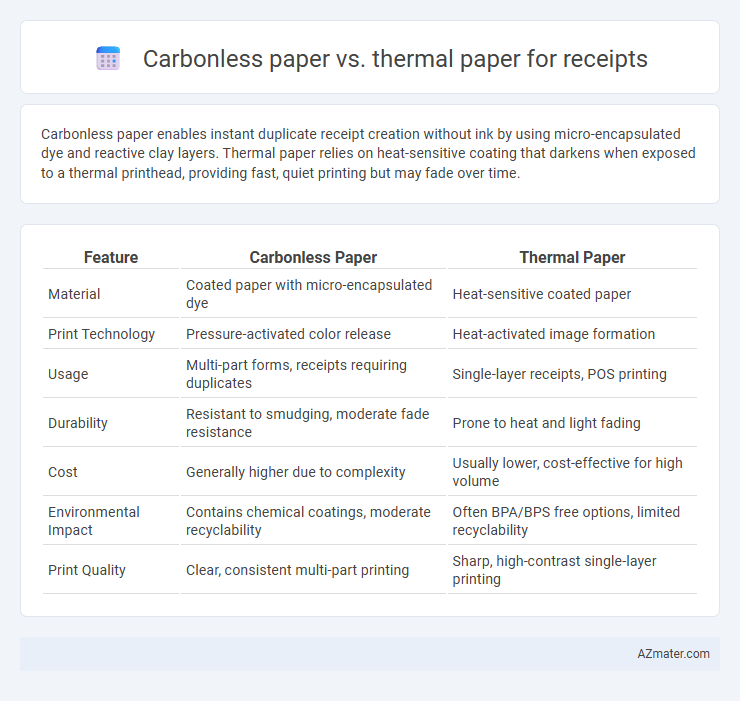Carbonless paper enables instant duplicate receipt creation without ink by using micro-encapsulated dye and reactive clay layers. Thermal paper relies on heat-sensitive coating that darkens when exposed to a thermal printhead, providing fast, quiet printing but may fade over time.
Table of Comparison
| Feature | Carbonless Paper | Thermal Paper |
|---|---|---|
| Material | Coated paper with micro-encapsulated dye | Heat-sensitive coated paper |
| Print Technology | Pressure-activated color release | Heat-activated image formation |
| Usage | Multi-part forms, receipts requiring duplicates | Single-layer receipts, POS printing |
| Durability | Resistant to smudging, moderate fade resistance | Prone to heat and light fading |
| Cost | Generally higher due to complexity | Usually lower, cost-effective for high volume |
| Environmental Impact | Contains chemical coatings, moderate recyclability | Often BPA/BPS free options, limited recyclability |
| Print Quality | Clear, consistent multi-part printing | Sharp, high-contrast single-layer printing |
Introduction to Receipt Paper Types
Receipt paper types primarily include carbonless paper and thermal paper, each serving distinct printing technologies. Carbonless paper relies on micro-encapsulated dye that transfers text upon impact, making it ideal for multi-copy receipts without ink. Thermal paper, coated with heat-sensitive chemicals, produces clear and fast prints through direct thermal printing, commonly used in POS systems due to its efficiency and low maintenance.
What is Carbonless Paper?
Carbonless paper is a special type of paper coated with micro-encapsulated dye or ink and reactive clay that creates instant duplicates without the need for carbon sheets, making it ideal for multi-part forms and receipts. It enables clear, legible copies by transferring pressure from written or printed text to the underlying sheets, offering a clean, eco-friendlier alternative to traditional carbon paper. Carbonless paper is preferred in environments requiring multiple identical copies, such as invoices or delivery receipts, due to its reliability and ease of use compared to thermal paper, which relies on heat-sensitive coating and is prone to fading over time.
What is Thermal Paper?
Thermal paper is a specially coated paper designed to change color when exposed to heat, eliminating the need for ink or toner in printing receipts. Commonly used in point-of-sale (POS) systems, thermal paper produces clear, fast-drying prints through thermal printheads, offering durability and resistance to smudging. Unlike carbonless paper, which relies on chemical reactions between coated sheets to create copies, thermal paper enables direct printing on a single sheet, making it preferred for efficient and high-speed receipt generation.
How Carbonless Paper Works
Carbonless paper, also known as NCR (No Carbon Required) paper, works by using micro-encapsulated dye or ink on the back of the top sheet and a reactive clay coating on the front of the sheet below. When pressure is applied by writing or printing, the microcapsules rupture, releasing the dye that reacts with the clay to form a permanent, clear duplicate copy without the need for carbon sheets. This technology provides clean, legible receipts ideal for multi-part forms, making it a preferred choice over thermal paper in environments requiring multiple identical copies.
How Thermal Paper Works
Thermal paper is specially coated with a heat-sensitive chemical layer that changes color when exposed to the heat from a thermal printer's print head, eliminating the need for ink or ribbons. This direct thermal process allows for fast, quiet printing ideal for receipts, labels, and tickets. Unlike carbonless paper, which relies on pressure to transfer micro-encapsulated ink, thermal paper achieves instant image formation through heat activation.
Pros and Cons of Carbonless Paper
Carbonless paper offers the advantage of producing instant duplicate copies without the need for ink or ribbon, making it ideal for multi-part receipts and minimizing smudges. Its drawbacks include sensitivity to heat and pressure, which can lead to unintended marks or fading over time, and limited environmental friendliness due to the chemical coatings used. Compared to thermal paper, carbonless paper provides better archival quality but tends to be less cost-effective and less compatible with high-speed, automated printing systems.
Pros and Cons of Thermal Paper
Thermal paper offers fast, noise-free printing and high-quality images without the need for ink or ribbons, making it cost-effective and low maintenance for receipt printing. However, thermal paper is sensitive to heat, light, and humidity, which can cause fading and reduced legibility over time, posing challenges for long-term document retention. While more environmentally friendly options exist, thermal paper often contains BPA or similar chemicals, raising health and ecological concerns compared to carbonless paper.
Cost Comparison: Carbonless vs Thermal Paper
Carbonless paper generally costs more initially than thermal paper due to its chemical coating, but it eliminates the need for ink cartridges, reducing long-term expenses. Thermal paper often offers lower upfront costs but requires specialized printers and can be more expensive to maintain with frequent replacements and sensitivity to heat and light. When comparing overall expenses, carbonless paper provides durability and cost-efficiency for multi-copy receipts, while thermal paper suits environments prioritizing quick, low-cost printing despite potential higher maintenance costs.
Environmental Impact and Safety
Carbonless paper reduces environmental impact by eliminating the need for carbon sheets, using micro-encapsulated dye technology that is less harmful than chemical-coated thermal paper. Thermal paper contains BPA or BPS, chemicals linked to health risks and environmental pollution, causing concerns during manufacturing and disposal. Choosing carbonless paper enhances safety and sustainability by minimizing toxic chemical exposure and improving recyclability compared to thermal paper.
Choosing the Right Receipt Paper for Your Business
Choosing the right receipt paper significantly impacts transaction clarity and durability; carbonless paper offers smudge-resistant, multi-copy functionality ideal for businesses requiring instant duplicate receipts, while thermal paper ensures faster printing with vibrant, sharp images but can fade over time when exposed to heat or light. Consider factors such as print longevity, cost-efficiency, type of printer compatibility, and the necessity for carbon copies when selecting between carbonless and thermal paper. Businesses prioritizing environmentally friendly options may prefer carbonless paper, which lacks the chemical coatings used in thermal variants, aligning with sustainability goals.

Infographic: Carbonless paper vs Thermal paper for Receipt
 azmater.com
azmater.com